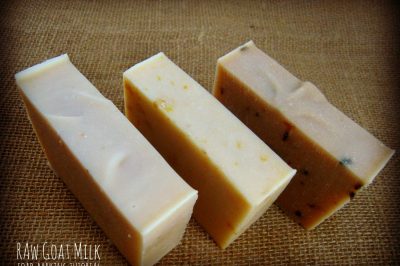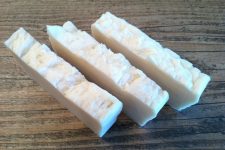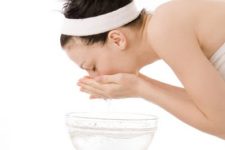It’s our first kidding season here at the ranch!
I can’t even describe to you the amount of cuteness happening around here! It’s just too much!
And with lots of super sweet baby goats…comes lots of super yummy goat’s milk!
Besides drinking it, making it into cheese, yogurt, and butter…I’m making soap!
For months, I searched high and low for a goat milk soap-making method that spoke to me.
I made lots of mistakes.
But finally…
…a goat milk soap recipe that’s just AMAZING!
Benefits of Goat Milk on Skin
Farm fresh goat milk is such a wonderful substance.
Goat’s milk is packed full of skin-loving nutrients such as:
- alpha-hydroxy acids
- vitamins B1, B6, B12, C, D, and E
- restorative natural emollients and triglycerides
When used topically — in handcrafted soaps — goat’s milk:
- acts as natural moisturizer
- effectively treats acne
- is less allergenic than chemical-laden, commercially-prepared soaps
- has the ability to reduce inflammation of the skin
- soothes dry and damaged skin
- slow premature aging of the skin
- heals eczema and psoriasis
Um…yes please!
Goat Milk Soap-Making Basics
The main concern with making goat’s milk soap — or any milk-based soap — is overheating of the milk.
When the milk over heats, you get scorched milk. Not good for soap-making. Scorched milk will leave your soap darkened…not to mention, it pretty much destroys all the nourishing benefits of the milk.
For these reasons, goat milk soap-making requires the use of the cold process soap method. Our aim is to maintain the integrity of the milk for maximum healing benefit.
Follow my instructions to the “T” and you’ll be fine!
Here we go!
How to Make Goat Milk Soap
Ingredients
*Measurements are by weight and should be made using a kitchen scale.
Base Oils
- 10 ounces shea butter
- 8 ounces coconut oil
- 8 ounces rice bran oil
- 6 ounces sunflower oil
- 4 ounces kokum butter
Lye Solution
- 4.8 ounces lye (7% excess fat)
- 6 ounces pure or distilled water
Add-Ins
- 8 ounces raw, farm-fresh goat milk
Optional Add-Ins
I like to add herbs in the form of flower petals, leaves, and powdered roots. Essential oils add loads of healing powers. Ingredients such as ground almonds, oatmeal, and raw honey are fun too! Get creative!
Method*Follow traditional cold process soap-making methods. For more information on the topic, I highly recommend these books by Susan Miller The Soapmaker’s Companion and The Natural Soap Book.
- Measure the base oils – by weight using a kitchen scale – and then place in a large pot to melt over low heat (this pot should be dedicated to soap-making).
- Once the oils are melted, leave pot on the counter until room temperature — this may take 8-10 hours or overnight.
- Measure both the lye and water – each in separate glass bowls — using a kitchen scale for the lye. Note: Always run your recipe through a lye calculator to be sure that you are using the proper amount of oils, lye, and liquid.
- Carefully combine the lye and water by pouring the lye into the water (never pour liquid into the lye) and stir liquid until lye is completely dissolved. The liquid is caustic and not to be touched in any way. The outside of the bowl will be extremely hot as well. Note: Be careful when working with lye and follow all of the recommended precautions. Keep out of reach of children. Don’t touch it. Use gloves, an apron, and protective eye wear. Basically, what I’m trying to say is, I can not be held responsible for any craziness, mishaps, explosions, etc. that may happen when making this recipe.
- Allow the lye mixture to stay under a vent and cool down to room temperature or at least 85 degrees F. Note: You can put the glass bowl containing the lye solution into an ice bath to speed up the process. Create an ice bath using another, larger bowl full of ice and water. Stir lye solution often.
- Now we’re ready to add the lye solution to the oils in the large pot.
- Stir, stir, stir. Note: Any equipment the lye touches needs to be neutralized in a mixture of white vinegar, soap, and water.
- After a brief stir, grab your stick blender and get to work! Blend the oils and liquid in the pot for at least 2 minutes. We are working toward “trace.”
- After 2 minutes — or once the mixture has reached “light trace” (like a thin pudding consistency) — stir in chilled (cold) goat’s milk using a non-wooden spoon.
- Stir for 1 minute. Note: If you are adding any “optional add-ins,” now’s the time to do that.
- Grab your stick blender again, and blend for an additional 1-2 minutes until your mixture is the consistency like that of thick pudding.
- Pour soap into prepared mold(s). Note: This recipe is enough to fill this Regular Silicone Loaf Soap Mold perfectly.
- Allow soap to cool and harden in the mold for 24-48 hours.
- Remove the soap from the mold on to a clean cutting surface. Using an appropriate cutting tool — such as this one — cut soap loaf into bars.
- Place bars on a rack with good airflow so that they can finish the saponification process. Note: These are the drying racks I use for all of my soaps.
- Allow soap to cure on drying racks for at least 4 weeks before using.
Where Can I Get This Stuff?
Looking for the raw materials mentioned in this post? The Soap Dish has some of the best prices on soap-making ingredients (this is where I purchase lye) you can find — not to mention it’s a small family owned business.
I also highly recommend Mountain Rose Herbs for high-quality, fair-trade, and organic herbs, oils, and essential oils!
Want to make the most amazing soap…use the most amazing ingredients! This is the BEST coconut oil on the planet.
Don’t know where to get farm fresh goat milk? Search LocalHarvest.org for a farmer near you.




 Raising Homesteading Dairy Goats
Raising Homesteading Dairy Goats
Great tutorial, Andrea 🙂 We love making goats milk soap and playing with different molds but I think my favorite soap is a simple bar that is a bit rustic looking!
You can also actually use the milk to completely replace the water. Just have it in a frozen slushy consistency and add the lye to it. I have also successfully used it in the hot process (crockpot) method starting with my frozen slush goats milk. Still turns out great!
Tammie, do you have a tutorial for goats milk soap in a crock pot? Sounds intriguing.
Congrats on your first season. Isn’t it fun? We have made two batches so far. Best soap ever, and we omit the shea butter so that it is great for hair too! I need to get another batch started!
Hi
Can you use Organic Dairy Milk from Grocery (not raw ) to replace the Goat raw milk ?
Question: What do you feed your goats during milking?
I always wondered about the lye in soaps, is it safe?
For all Soap Makers:
Do you like to know the % of GLYCERIN in your Soap Bars ?
Use the following Soap Calculator:
http://www.soapworld.biz/soap%20calculator.html
Bye!
Thank you so much for sharing!! I’ve been keeping my eye out for a great goat’s milk recipe, (mine have failed miserably). I can’t wait to try it!!
Wonderful… I love natural soap especially made up with essential oils like tea tree oil. When such essential oils are added to these soaps, common skin disorders like acne, rashes and ringworm can be treated.